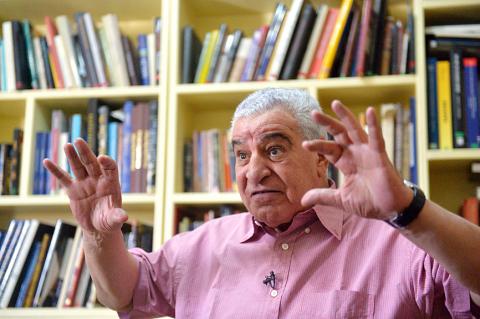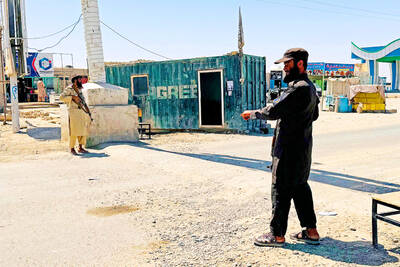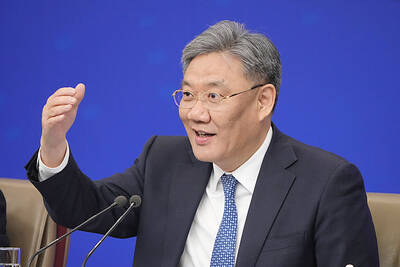From the Giza Pyramids to the pharaonic tombs of Luxor, Egypt’s ancient monuments are holding on to mysteries which researchers aim to unravel with cutting-edge technology.
For more than 200 years since Napoleon Bonaparte landed in Egypt with a retinue of scholars who laid the groundwork for modern Egyptology, experts have used science to unlock the secrets of the country’s ancient treasures.
In the 21st century, the scientists have been using electronic devices and chemical testing to date artefacts.

Photo: AFP
Chemical testing still requires small samples, but advanced techniques coming into use are meant to be non-invasive so as not to damage the ancient relics.
ScanPyramids is among the most ambitious of the projects to demystify the Khufu Pyramid near Cairo, the only surviving monument from the ancient Seven Wonders of the World.
It has employed infrared thermography and muography — a technique that records images using muon particles — in its quest.
The project had announced in October last year that the massive pyramid might contain undiscovered recesses.
“All the devices we put in place are designed to find where the cavity is located. We know there is one, but we’re trying to find out where,” said Mehdi Tayoubi, president of the HIP Institute heading the ScanPyramids project.
The muon devices include chemical emulsion instruments from Japan’s University of Nagoya, electronic sensors from the KEK Japanese Research Laboratory and muon telescopes from the French Atomic Energy Commission. The results are compared with infrared and 3D images.
Some archeologists have pinned hopes on the sophisticated technology to locate the burial place of the legendary queen Nefertiti.
The wife of King Akhenaten, who initiated a monotheistic cult in ancient Egypt, Nefertiti remains an enigma, best known for a bust depicting her that is on exhibition in Berlin’s Neues Museum.
British Egyptologist Nicholas Reeves believed her remains were hidden in a secret chamber in the tomb of Tutankhamun, in the southern Valley of the Kings.
In 2015, archeologists scanned the tomb with radar hoping for clues. Both Reeves’ theory and the inconclusive results have been dismissed by other Egyptologists.
One of them, former Egyptian minister of state for antiquities Zahi Hawass, said that an adept of the sun god Aton would never have been allowed to be buried in the Valley of the Kings.
The excitement over the possible discovery has died down since the inconclusive results, but a team from Politecnico University in Turin, Italy, intends to give it another shot.
This time they are to employ tomography — a method used in medical scans — and magnetometry, which measures magnetic fields.
Neither the Politecnico team nor the Egyptian Ministry of State for Antiquities has been inclined to discuss the fresh attempt, possibly put off by the anticlimactic media frenzy over the previous bid.
Elsewhere, Egyptologists are undertaking a project to nail down the chronology of Egypt’s ancient dynasties more precisely.
The French Institute of Eastern Archaeology (IFAO) in Cairo has a dating laboratory that the researchers are putting to use for the project.
“The chronology of ancient Egypt is not clearly defined. We use a relative chronology,” IFAO head of research Anita Quiles said.
“We refer to reigns and dynasties, but we do not know exactly the dates,” she said.
The investigation, which involves chemical testing, is expected to take several years.
However, Egyptologists say that science cannot replace archeologists and their work on the ground.
“It is important to have science in archeology, but it is very important not to let scientists announce any details about what they found unless it has been seen by Egyptologists,” Hawass said.

‘EYE FOR AN EYE’: Two of the men were shot by a male relative of the victims, whose families turned down the opportunity to offer them amnesty, the Supreme Court said Four men were yesterday publicly executed in Afghanistan, the Supreme Court said, the highest number of executions to be carried out in one day since the Taliban’s return to power. The executions in three separate provinces brought to 10 the number of men publicly put to death since 2021, according to an Agence France-Presse tally. Public executions were common during the Taliban’s first rule from 1996 to 2001, with most of them carried out publicly in sports stadiums. Two men were shot around six or seven times by a male relative of the victims in front of spectators in Qala-i-Naw, the center

Incumbent Ecuadoran President Daniel Noboa on Sunday claimed a runaway victory in the nation’s presidential election, after voters endorsed the young leader’s “iron fist” approach to rampant cartel violence. With more than 90 percent of the votes counted, the National Election Council said Noboa had an unassailable 12-point lead over his leftist rival Luisa Gonzalez. Official results showed Noboa with 56 percent of the vote, against Gonzalez’s 44 percent — a far bigger winning margin than expected after a virtual tie in the first round. Speaking to jubilant supporters in his hometown of Olon, the 37-year-old president claimed a “historic victory.” “A huge hug

Canadian Prime Minister Mark Carney is leaning into his banking background as his country fights a trade war with the US, but his financial ties have also made him a target for conspiracy theories. Incorporating tropes familiar to followers of the far-right QAnon movement, conspiratorial social media posts about the Liberal leader have surged ahead of the country’s April 28 election. Posts range from false claims he recited a “satanic chant” at a campaign event to artificial intelligence (AI)-generated images of him in a pool with convicted sex offender Jeffrey Epstein. “He’s the ideal person to be targeted here, for sure, due to

DISPUTE: Beijing seeks global support against Trump’s tariffs, but many governments remain hesitant to align, including India, ASEAN countries and Australia China is reaching out to other nations as the US layers on more tariffs, in what appears to be an attempt by Beijing to form a united front to compel Washington to retreat. Days into the effort, it is meeting only partial success from countries unwilling to ally with the main target of US President Donald Trump’s trade war. Facing the cratering of global markets, Trump on Wednesday backed off his tariffs on most nations for 90 days, saying countries were lining up to negotiate more favorable conditions. China has refused to seek talks, saying the US was insincere and that it